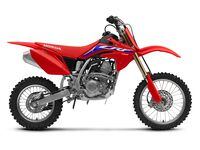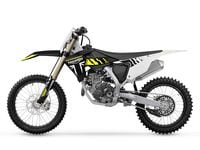Grant gets grilled on the performance of the piston, head and the most recent FMF muffler.
Supercross does everything possible to make the first appearance of the top riders and machines a true spectacle. Often the bike and rider burst from obscurity into a bizarre double life: Reality on the track and in surreal-size on the diamond-vision screen. Bike and rider embody perfection as they dodge exploding fireworks, wheelie through smoke and fight a cascading soundtrack that dwarfs the crackle of a race-tuned 450cc four-stroke. Sponsors and teams make sure that the bike and rider are turned out in detail that can't possibly be fully appreciated from the stands. But at that moment, the bike you see is the tip of an iceberg-the bike on the SX track is the pinnacle above water, but it is supported by an unseen mass of money, testing, sweat and technology expended to arrive at the moment of unveiling. Dirt Rider wanted to follow the conception, birth and life of a brand-new 2010 SX weapon, and one of the Yamaha teams felt like the perfect subject. The new YZ450F is so radically new that even an existing Yamaha team would virtually be starting from scratch. To ferret out this information from an OEM team would have meant gnawing through layers of secrecy and combating corporate butt-covering, so that was out. On the other hand, we wanted a team that was doing far more than merely bolting on aftermarket parts. We quickly narrowed the possibilities to the Muscle Milk/Toyota/JGRMX Team. JGR is somewhat removed from under the corporate thumb by virtue of paying for its bikes and parts. At the same time, the expertise and resources available to the team are unrivaled. A late release of bikes and parts and typical North Carolina weather had Muscle Milk/Toyota/JGRMX techs scrambling to finalize settings and get team riders Josh Grant and Justin Brayton acclimated to the new machinery.Every pure-blooded dirt rider has been waiting with sweaty palms for a ride on the 2010 Yamaha, but when JGRMX got a single bike in mid-October 2009, there were no parts. Team manager Jeremy Albrecht explained his thinking on the situation: "Riding the bike with no parts was pointless for us, so we tore the bike completely apart and sent the valves, piston and pipe to Xceldyne, JE and FMF so they could get started on race parts. In the meantime we put the fork and shock on the dyno to approximate our 2009 SX suspension settings so we would have a starting point. We rode the bike for the first time on November 12th." If you are paying attention, you will note that none of the team riders have even ridden the stock bike. Team R&D; tech Spencer Bloomer explained that, "It wouldn't be safe for our riders to attempt an SX track with stock suspension. If the outdoor series were first, and we had the luxury of time, then sure the riders might have ridden the bikes stock, but not with the SX series rushing up at us." Our readers moan about pulling the linkage on a new bike to grease it before riding, and these guys tear a brand-new bike to bits and wait a month before riding it!Next up was an unconventional decision on suspension. In the past the JGR bikes looked a great deal like factory Yamahas, and especially during the first year, we were amazed that a new team had the juice to get so many factory parts. Team leader Coy Gibbs shone a light on that. "We can buy Yamaha factory parts, and we still use the transmissions and titanium bolt kits, but eventually we'd like to be as self sufficient as possible. For example, we have our own brand of lubricants, we have a retail engine and suspension business, and we may have some hard parts for sale in 2010 as well. For 2010 the price of the factory suspension went way up, and we decided to look at alternatives. We could have used the 2009 fork, but the new shock is too different. We decided to use a Showa fork, and we have a proprietary shock built by JRI Shocks. JRI makes shocks for F1 and NASCAR, but some of the technicians got their start at Fox, and they have many years of motocross suspension experience but amplified with the resources and knowledge gleaned from automotive applications." When we were with JGR the shock was still a prototype in raw billet aluminum, but the plans were for a coated and finished version for Anaheim 1. The choice of a Showa fork made additional work for R&D; tech Spencer Bloomer. "Showa doesn't have an axle lug for a Yamaha, so I had to design one on the computer, and the machine shop at the JGR NASCAR shop machined them for us. We had to design our own triple clamps and have those machined here as well."
Grant gets grilled on the performance of the piston, head and the most recent FMF muffler.
During the three days we had in NC, the team was chasing dry dirt. Mud makes for poor SX testing. One day we drove to a home SX track with a sandy base in South Carolina, and basically Grant had more time to get used to the snap and response of the nearly stock-motored FI bike, so he could get his timing solidly down. And the end of the day there he commented that he was ready for more power.On our final day, the time crunch of the January 9th season start and a 100-percent chance of rain and snow forecast for the following day forced the team to JGR's Mark Barnett-built SX track. It was a given that the expensive track would take some abuse, but it couldn't be helped. Grant pronounced the track too wet after a few exploratory laps, so he sent his muddy bike off with Shawn Ulikowski to get a 10mm lower subframe, a race piston and a new Dean Baker-modified head. While Ulikowski washed and tore down the YZ, Bloomer attacked the track in a small skid-steer to pack the surface with the rubber tracks. Grant fired up the dozer and helped force the track into riding condition as well. Eventually nearly the entire team was on hand as well as three reps from JRI. There were seven or eight trucks (Toyota of course) and the team's testing transporter and trailer. Grant spent over an hour on the dozer, and finished up on the track before the engine rebuild was complete, so one JRI shock went on Brayton's machine, and he put enough laps in to break the track in a bit. His bike went back for a shock change, so Brayton went into the skid-steer for more track work until Grant's new top end was ready for break-in. With the track further dialed in, Grant was tasked with testing three variations of FMF exhaust. Then it was Grant's turn to test a JRI shock, but first Jonny Oler and a JRI tech revalved it from the Brayton test setting. With darkness just about at hand, Grant went out for a final test session. He picked up enough speed to have trouble making the turn after the stadium whoop section.The next day NC was clobbered with a snow storm, and testing was pretty much halted until after the Christmas holidays. In 2009 the team had all SX testing completed in early November, but events this year will force them to continue testing during the season between races. But back at the shop work continued: Parts shipments to put away, finish details on the transporter and trailer, spare race engines are assembled, and the actual SX race bikes are being built up from parts. Apparently it is easier and cheaper that way when so many of the parts and all of the hardware would be replaced. At the end of the year the race bikes will be reduced to parts again.A modern 450 is more bike than the vast majority of riders can fully exploit or even need. But at the level of the top riders, things are very different. Much of what is called the R&D; process has to do with personalizing a machine for a particular rider, but performance is a big part as well. For sure the suspension end is probably more important, but many riders demand added engine performance as well. Brayton claimed, "When I was on the 450 KTM last year, I kept asking for more power. Finally it was over 60 horsepower on the dyno, and the tech said that was all there was in a 450, and I loved having that power." The two JGRMX team riders are supported by 13 full-time staff in addition to part-time assets they draw on from the JGR car side. Remember that iceberg? There is a lot going on under the surface to support a rider and machine at the cutting edge of SX. Two years ago the Joe Gibbs Racing MX team was an oddity: located near Charlotte, NC, all of the team members living near the race shop and a unique way of doing things. But from what we saw-a virtually new bike developed race ready in mere days-the team has a lot going for it. Next step: its own indoor track.












/cloudfront-us-east-1.images.arcpublishing.com/octane/TNWYBCGJB5H45PLJQBCOLD5RWU.jpg)
/cloudfront-us-east-1.images.arcpublishing.com/octane/IRZZYHO4XVDHRH22P2ZDQDRYHM.jpg)
/cloudfront-us-east-1.images.arcpublishing.com/octane/NNX5PHJJTBCKNJGQDQZDFRHYR4.jpg)

/cloudfront-us-east-1.images.arcpublishing.com/octane/3GVBLEXDJBCMDPQSU3DCLA2ZIU.jpg)

/cloudfront-us-east-1.images.arcpublishing.com/octane/VM4IESJWNVADRCTV4XHH24PGPA.jpg)
/cloudfront-us-east-1.images.arcpublishing.com/octane/HM5XHDOCUJAONMRU7G3W3XT3DM.jpg)
/cloudfront-us-east-1.images.arcpublishing.com/octane/PKDJEFNWPFC5FBQIQKWFNZXUWQ.jpg)
/cloudfront-us-east-1.images.arcpublishing.com/octane/52VYACHLOJFIJBXCVVF6HOBTXQ.jpg)
/cloudfront-us-east-1.images.arcpublishing.com/octane/EMZFWPV7WRDXBO5MLMM6K3UVYI.jpg)
/cloudfront-us-east-1.images.arcpublishing.com/octane/7UZTUEXJIRB7TEFC4AL3JFBH2I.jpg)
/cloudfront-us-east-1.images.arcpublishing.com/octane/HKD4ZFEEENFJHHXSB6KTJI3FWQ.jpg)
/cloudfront-us-east-1.images.arcpublishing.com/octane/LH7UVED36VFYDPF5A3KQFITAH4.jpg)
/cloudfront-us-east-1.images.arcpublishing.com/octane/EY2VN2TTQFEJZDSC7ZGZ56WCYI.jpg)
/cloudfront-us-east-1.images.arcpublishing.com/octane/2SM4ULIAVNGGHHDUKX6SYM54EU.jpg)
/cloudfront-us-east-1.images.arcpublishing.com/octane/YXOSJ6I63NCMTFONHYHSNC4F2Y.jpg)
/cloudfront-us-east-1.images.arcpublishing.com/octane/XLOLUX32YNFAPOSIW66MPKPZWU.jpg)
/cloudfront-us-east-1.images.arcpublishing.com/octane/7DFD3M45PRGDNNOJZN2OVZC5WI.jpg)
/cloudfront-us-east-1.images.arcpublishing.com/octane/3KOF6RMQFRA2HCFI5B4F35V5R4.jpg)
/cloudfront-us-east-1.images.arcpublishing.com/octane/DBVJETHGPRE4BFMDJUZ6JDSWWE.jpg)
/cloudfront-us-east-1.images.arcpublishing.com/octane/X2MQDB3UYZAIDGAPPP7UR6FHDE.jpg)
/cloudfront-us-east-1.images.arcpublishing.com/octane/5JN2YI5OWBFKVJWSZJSGX4NWFE.jpg)
